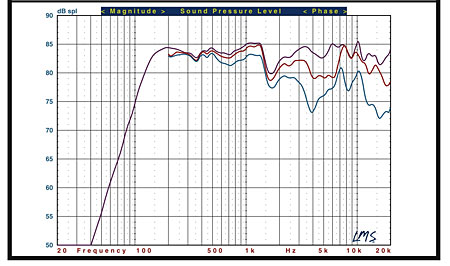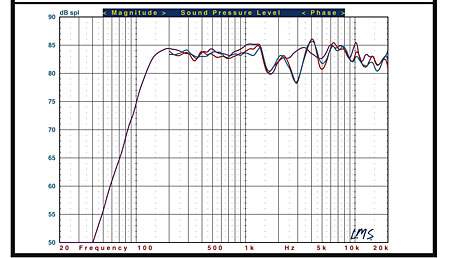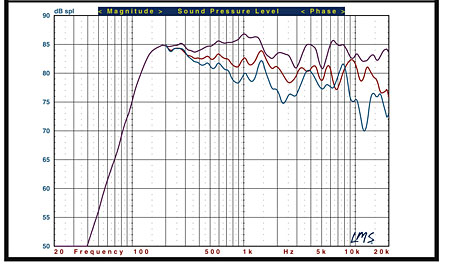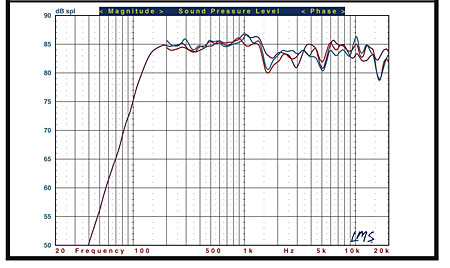KEF KHT 5005.2 Wireless Surround Speaker System with Wireless 5000 Series Option Measurements
All measurements on the KEFs were made with their non-removable grilles in place, driven conventionally without the RF package.
Apart from their orientation and mounting attachments, the HTS5001.2 and the HTC5001.2 are essentially the same speaker. Many of their characteristics, therefore, are largely identical, apart from sample variations and orientation.
The impedance of both models is typical of a sealed box tuned to approximately 150Hz, with a minimum impedance of approximately 4.2Ω at about 330Hz. I judge their nominal impedance to be about 7Ω, with a relatively benign phase angle in the region of the speakers' lowest impedance that should make them a relatively easy load to drive.
At approximately 84dB/2.83V/m, however, the sensitivity of both the HTS5001.2 and HTC5001.2 is much lower than average. Their impedance also turns highly capacitive at very low frequencies, suggesting the presence of a blocking capacitor in the crossover. This is likely intended to prevent some pyro from driving the speakers full range and blowing out the small drivers in a futile attempt to get deep bass from them. Since the effective lower limit of their bass (-10dB) is about 100Hz, these speakers must be used with a subwoofer, crossed over at a minimum of 80-100Hz, to generate any meaningful bass. With such a crossover, the high capacitance at low frequencies should not be a concern.
The front horizontal response of the HTS5001.2 is shown in Fig.1 (violet). This is the pseudo-anechoic response averaged over a 30° forward horizontal angle, taken at tweeter height, combined with the nearfield response of the woofers.

Fig.1: KEF HTS5001.2, pseudo-anechoic horizontal response at 45° (red) and 60° (blue).
This ±15° averaged front horizontal response is fairly linear above 150Hz, apart from a dip at about 1.7kHz. The horizontal off-axis response is not as pretty, but it's a good match for the direct response up to 30° off-axis (not shown).
Fig.2 shows the same averaged horizontal front response (purple), this time overlaid with the vertical responses taken at +15° (red) and –15° (blue). These curves suggest that your vertical ear position relative to the tweeter, within reason, should not be particularly critical with this speaker. But the vertical response is still best on the tweeter axis. Move much above or below that axis and a noticeable dip is added at 3kHz.

Fig.2: KEF HTS5001.2, pseudo-anechoic vertical response at 15° above (red) and 15° below (blue) the tweeter axis.
The measured front horizontal response of the HTC5001.2, taken on the tweeter axis and averaged in the same manner as described above for the HTS5001.2, is shown in Fig.3 (violet curve). It's a bit lumpier than the response of the HTS5001.2, with the differences likely due mainly to the horizontal orientation and, possibly, unit-to-unit sample variations. The sort if off-axis interference suckouts we see in many horizontal center channel designs is, however, minimal here, at least up to 45°.

Fig.3: KEF HTC5001.2, pseudo-anechoic horizontal response at 45° (red) and 60° (blue).
Fig.4 shows the vertical response of the HTC5001.2 at + 15° (red) and –15° (blue), overlaid again with the averaged front horizontal response. Within those limits, the vertical position of the listener is not critical.

Fig.4: KEF HTC5001.2, pseudo-anechoic vertical response at 15° above (red) and 15° below (blue) the tweeter axis.
These measurements are respectable for a speaker in this price range, though in no way remarkable, apart perhaps from the relative uniformity of the center channel's response at off-axis seating positions. Good, larger speakers at competitive prices, including I suspect some of KEF's own more conventional designs, can offer better measured performance, with more extended bass and higher sensitivity.
All figures: Violet curve: pseudo-anechoic response on tweeter axis, averaged across a 30° horizontal window, combined with nearfield responses of the woofers response. All measurements taken at 1-meter.





























































